[English] 日本語
 Yorodumi
Yorodumi- PDB-6gyp: Cryo-EM structure of the CBF3-core-Ndc10-DBD complex of the buddi... -
+ Open data
Open data
- Basic information
Basic information
| Entry | Database: PDB / ID: 6gyp | |||||||||
|---|---|---|---|---|---|---|---|---|---|---|
| Title | Cryo-EM structure of the CBF3-core-Ndc10-DBD complex of the budding yeast kinetochore | |||||||||
 Components Components |
| |||||||||
 Keywords Keywords | CELL CYCLE / Complex | |||||||||
| Function / homology |  Function and homology information Function and homology informationRAVE complex / Iron uptake and transport / CBF3 complex / regulation of transcription by galactose / regulation of sulfur amino acid metabolic process / cellular response to methylmercury / vacuolar proton-transporting V-type ATPase complex assembly / septin ring assembly / mitotic spindle elongation / centromeric DNA binding ...RAVE complex / Iron uptake and transport / CBF3 complex / regulation of transcription by galactose / regulation of sulfur amino acid metabolic process / cellular response to methylmercury / vacuolar proton-transporting V-type ATPase complex assembly / septin ring assembly / mitotic spindle elongation / centromeric DNA binding / regulation of exit from mitosis / kinetochore assembly / condensed chromosome, centromeric region / positive regulation of glucose transmembrane transport / regulation of metabolic process / protein neddylation / mitotic intra-S DNA damage checkpoint signaling / vacuolar acidification / silent mating-type cassette heterochromatin formation / DNA binding, bending / spindle pole body / mitochondrial fusion / exit from mitosis / SCF ubiquitin ligase complex / SCF-dependent proteasomal ubiquitin-dependent protein catabolic process / FBXL7 down-regulates AURKA during mitotic entry and in early mitosis / mitotic spindle assembly checkpoint signaling / Orc1 removal from chromatin / cullin family protein binding / DNA replication origin binding / Antigen processing: Ubiquitination & Proteasome degradation / subtelomeric heterochromatin formation / regulation of protein-containing complex assembly / spindle midzone / endomembrane system / negative regulation of cytoplasmic translation / regulation of mitotic cell cycle / chromosome segregation / kinetochore / spindle / G1/S transition of mitotic cell cycle / G2/M transition of mitotic cell cycle / mitotic cell cycle / ubiquitin-dependent protein catabolic process / protein-containing complex assembly / chromosome, telomeric region / DNA-binding transcription factor activity, RNA polymerase II-specific / protein ubiquitination / DNA binding / zinc ion binding / identical protein binding / nucleus / cytoplasm Similarity search - Function | |||||||||
| Biological species |  | |||||||||
| Method | ELECTRON MICROSCOPY / single particle reconstruction / cryo EM / Resolution: 3.6 Å | |||||||||
 Authors Authors | Yan, K. / Zhang, Z. / Yang, J. / McLaughlin, S.H. / Barford, D. | |||||||||
| Funding support |  United Kingdom, 2items United Kingdom, 2items
| |||||||||
 Citation Citation |  Journal: Nat Struct Mol Biol / Year: 2018 Journal: Nat Struct Mol Biol / Year: 2018Title: Architecture of the CBF3-centromere complex of the budding yeast kinetochore. Authors: Kaige Yan / Ziguo Zhang / Jing Yang / Stephen H McLaughlin / David Barford /  Abstract: Kinetochores are multicomponent complexes responsible for coordinating the attachment of centromeric DNA to mitotic-spindle microtubules. The point centromeres of budding yeast are organized into ...Kinetochores are multicomponent complexes responsible for coordinating the attachment of centromeric DNA to mitotic-spindle microtubules. The point centromeres of budding yeast are organized into three centromeric determining elements (CDEs), and are associated with the centromere-specific nucleosome Cse4. Deposition of Cse4 at CEN loci is dependent on the CBF3 complex that engages CDEIII to direct Cse4 nucleosomes to CDEII. To understand how CBF3 recognizes CDEIII and positions Cse4, we determined a cryo-EM structure of a CBF3-CEN complex. CBF3 interacts with CEN DNA as a head-to-head dimer that includes the whole of CDEIII and immediate 3' regions. Specific CEN-binding of CBF3 is mediated by a Cep3 subunit of one of the CBF3 protomers that forms major groove interactions with the conserved and essential CCG and TGT motifs of CDEIII. We propose a model for a CBF3-Cse4-CEN complex with implications for understanding CBF3-directed deposition of the Cse4 nucleosome at CEN loci. | |||||||||
| History |
|
- Structure visualization
Structure visualization
| Movie |
 Movie viewer Movie viewer |
|---|---|
| Structure viewer | Molecule:  Molmil Molmil Jmol/JSmol Jmol/JSmol |
- Downloads & links
Downloads & links
- Download
Download
| PDBx/mmCIF format |  6gyp.cif.gz 6gyp.cif.gz | 415.9 KB | Display |  PDBx/mmCIF format PDBx/mmCIF format |
|---|---|---|---|---|
| PDB format |  pdb6gyp.ent.gz pdb6gyp.ent.gz | 329.8 KB | Display |  PDB format PDB format |
| PDBx/mmJSON format |  6gyp.json.gz 6gyp.json.gz | Tree view |  PDBx/mmJSON format PDBx/mmJSON format | |
| Others |  Other downloads Other downloads |
-Validation report
| Arichive directory |  https://data.pdbj.org/pub/pdb/validation_reports/gy/6gyp https://data.pdbj.org/pub/pdb/validation_reports/gy/6gyp ftp://data.pdbj.org/pub/pdb/validation_reports/gy/6gyp ftp://data.pdbj.org/pub/pdb/validation_reports/gy/6gyp | HTTPS FTP |
|---|
-Related structure data
| Related structure data |  0095MC  0096C  0097C  6gysC  6gyuC M: map data used to model this data C: citing same article ( |
|---|---|
| Similar structure data |
- Links
Links
- Assembly
Assembly
| Deposited unit | 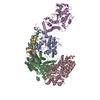
|
|---|---|
| 1 |
|
- Components
Components
-Centromere DNA-binding protein complex CBF3 subunit ... , 4 types, 4 molecules BACE
| #1: Protein | Mass: 71439.891 Da / Num. of mol.: 1 Source method: isolated from a genetically manipulated source Source: (gene. exp.)   unidentified baculovirus / References: UniProt: P40969 unidentified baculovirus / References: UniProt: P40969 |
|---|---|
| #2: Protein | Mass: 56416.863 Da / Num. of mol.: 1 Source method: isolated from a genetically manipulated source Source: (gene. exp.)   unidentified baculovirus / References: UniProt: P35203 unidentified baculovirus / References: UniProt: P35203 |
| #3: Protein | Mass: 66401.859 Da / Num. of mol.: 1 Source method: isolated from a genetically manipulated source Source: (gene. exp.)   unidentified baculovirus / References: UniProt: P40969 unidentified baculovirus / References: UniProt: P40969 |
| #5: Protein | Mass: 112066.031 Da / Num. of mol.: 1 Source method: isolated from a genetically manipulated source Source: (gene. exp.)   unidentified baculovirus / References: UniProt: P32504 unidentified baculovirus / References: UniProt: P32504 |
-Protein , 1 types, 1 molecules D
| #4: Protein | Mass: 22357.270 Da / Num. of mol.: 1 Source method: isolated from a genetically manipulated source Source: (gene. exp.)   unidentified baculovirus / References: UniProt: P52286 unidentified baculovirus / References: UniProt: P52286 |
|---|
-Non-polymers , 6 types, 7 molecules 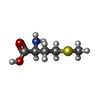
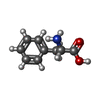
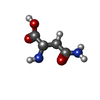
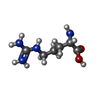
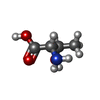
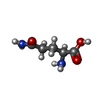





| #6: Chemical | ChemComp-MET / | ||
|---|---|---|---|
| #7: Chemical | ChemComp-PHE / | ||
| #8: Chemical | ChemComp-ASN / | ||
| #9: Chemical | ChemComp-ARG / | ||
| #10: Chemical | | #11: Chemical | ChemComp-GLN / | |
-Experimental details
-Experiment
| Experiment | Method: ELECTRON MICROSCOPY |
|---|---|
| EM experiment | Aggregation state: PARTICLE / 3D reconstruction method: single particle reconstruction |
- Sample preparation
Sample preparation
| Component | Name: CBF3-core-Ndc10-DBD complex / Type: COMPLEX / Entity ID: #1-#5 / Source: RECOMBINANT |
|---|---|
| Source (natural) | Organism:  |
| Source (recombinant) | Organism:  unidentified baculovirus unidentified baculovirus |
| Buffer solution | pH: 8 |
| Specimen | Conc.: 0.4 mg/ml / Embedding applied: NO / Shadowing applied: NO / Staining applied: NO / Vitrification applied: YES |
| Vitrification | Cryogen name: ETHANE |
- Electron microscopy imaging
Electron microscopy imaging
| Experimental equipment |  Model: Titan Krios / Image courtesy: FEI Company |
|---|---|
| Microscopy | Model: FEI TITAN KRIOS |
| Electron gun | Electron source:  FIELD EMISSION GUN / Accelerating voltage: 300 kV / Illumination mode: FLOOD BEAM FIELD EMISSION GUN / Accelerating voltage: 300 kV / Illumination mode: FLOOD BEAM |
| Electron lens | Mode: BRIGHT FIELD |
| Image recording | Electron dose: 27 e/Å2 / Detector mode: COUNTING / Film or detector model: FEI FALCON III (4k x 4k) |
- Processing
Processing
| Software |
| ||||||||||||||||||||||||
|---|---|---|---|---|---|---|---|---|---|---|---|---|---|---|---|---|---|---|---|---|---|---|---|---|---|
| CTF correction | Type: PHASE FLIPPING AND AMPLITUDE CORRECTION | ||||||||||||||||||||||||
| 3D reconstruction | Resolution: 3.6 Å / Resolution method: FSC 0.143 CUT-OFF / Num. of particles: 73894 / Symmetry type: POINT | ||||||||||||||||||||||||
| Atomic model building | Protocol: OTHER | ||||||||||||||||||||||||
| Refinement | Stereochemistry target values: GeoStd + Monomer Library | ||||||||||||||||||||||||
| Refine LS restraints |
|
 Movie
Movie Controller
Controller



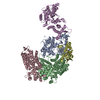
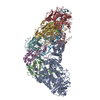
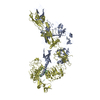
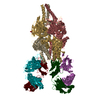
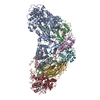



 PDBj
PDBj


















